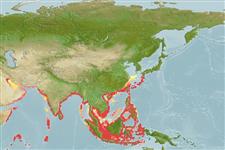Environment: milieu / climate zone / depth range / distribution range
Ökologie
seewasser; brackwasser benthopelagisch; amphidrom (Ref. 51243); tiefenbereich 10 - ? m (Ref. 9811). Tropical; 32°N - 10°S, 48°E - 131°E
Indo-West Pacific: Persian Gulf to eastern Indonesia, north to Japan. Not recorded from Australia or New Guinea.
Size / Gewicht / Alter
Maturity: Lm ? range ? - ? cm
Max length : 40.0 cm TL Männchen/unbestimmt; (Ref. 3517); common length : 20.0 cm TL Männchen/unbestimmt; (Ref. 3517)
Rückenflossenstacheln (insgesamt): 0; Rückenflossenweichstrahlen (insgesamt): 43-50; Afterflossenweichstrahlen: 39 - 42; Wirbelzahl: 33. Greyish to brownish dorsally, silvery white on sides. Covered in dark pigment spots. Fins silvery to greyish, darkest distally. Body firm, very deep, compressed. Caudal peduncle short, deep, strongly compressed, lacking scute-like scales or fleshy keels. Snout blunt, rounded, forehead almost straight. Eye small, central, much shorter than snout. Mouth small, subterminal, curved downward posteriorly, not reaching anterior margin of eye. Upper jaw covered with skin, joined to head, not movable. Jaw teeth minute, in a single series, flattened with 3 cusps (central cusp much larger than those adjacent). Gill membranes joined to belly. Gill slit short, its lower margin slightly below pectoral-fin base. Scales very small, cycloid, and deciduous, barely extending onto fin bases. Naked patch on head and nape with well-defined network of longitudinal sensory canals, patch not extending above pectoral-fin base. Lateral line high, following dorsal profile onto caudal peduncle (Ref 12928).
Occurs seasonally singly or in small schools over muddy bottoms; may enter estuaries. Feeds on ctenophores, salps, medusae, and other zooplankton groups but will also prey on small benthic animals. Sold fresh in markets (Ref. 9811).
Life cycle and mating behavior
Geschlechtsreife | Fortpflanzung | Ablaichen | Eier | Fecundity | Larven
Last, P.R., 1997. Stromateidae. Butterfishes, silver pomfrets. In K.E. Carpenter and V. Niem (eds.) FAO Identification Guide for Fishery Purposes. The Western Central Pacific. (in preparation). (Ref. 9811)
IUCN Rote Liste Status (Ref. 130435)
Bedrohung für Menschen
Harmless
Nutzung durch Menschen
Fischereien: weniger kommerziell
Mehr Information
NamenSynonymeMetabolismusRäuberÖkotoxikologieFortpflanzungGeschlechtsreifeAblaichenSpawning aggregationFecundityEierEientwicklung
PartnerBilderStamps, Coins Misc.LauteCiguateraGeschwindigkeitSchwimmstilKiemenoberflächeOtolithsGehirngrößeSehfähigkeit
Tools
Zusatzinformationen
Download XML
Internet Quellen
Estimates based on models
Preferred temperature (Ref.
123201): 24.8 - 29.2, mean 28.5 °C (based on 508 cells).
Phylogenetic diversity index (Ref.
82804): PD
50 = 0.5313 [Uniqueness, from 0.5 = low to 2.0 = high].
Bayesian length-weight: a=0.01738 (0.00822 - 0.03676), b=3.01 (2.83 - 3.19), in cm total length, based on LWR estimates for this species & (Sub)family-body (Ref.
93245).
Trophic level (Ref.
69278): 3.6 ±0.38 se; based on food items.
Generation time: 1.6 ( na - na) years. Estimated as median ln(3)/K based on 1
growth studies.
Widerstandsfähigkeit (Ref.
120179): hoch, Verdopplung der Population dauert weniger als 15 Monate. (K=0.6).
Fishing Vulnerability (Ref.
59153): Low vulnerability (24 of 100).
Nutrients (Ref.
124155): Calcium = 58.5 [23.8, 140.8] mg/100g; Iron = 0.512 [0.256, 1.080] mg/100g; Protein = 17.4 [16.1, 18.7] %; Omega3 = 0.205 [0.109, 0.377] g/100g; Selenium = 124 [34, 456] μg/100g; VitaminA = 21.4 [6.9, 62.3] μg/100g; Zinc = 0.743 [0.449, 1.403] mg/100g (wet weight); based on
nutrient studies.
